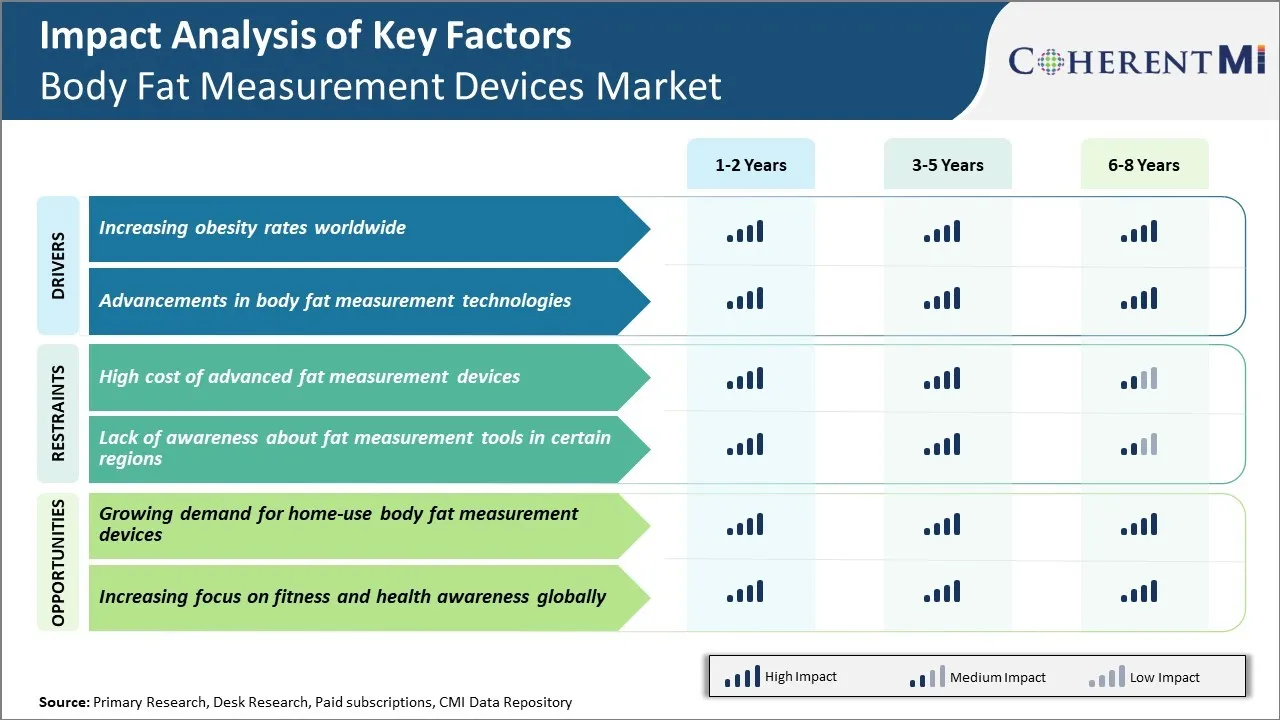Mercado de dispositivos de medição de gordura corporal ANÁLISE DE TAMANHO E PARTICIPAÇÃO - TENDÊNCIAS DE CRESCIMENTO E PREVISÕES (2024 - 2031)
O Mercado de Dispositivos de Medição de Gordura de Corpo é segmentado por Produto (Analisador de Impedância Bioelétrica, Fitas de Medição de Circunfer....
Mercado de dispositivos de medição de gordura corporal Tendências
Driver de mercado - Aumentando as taxas de obesidade em todo o mundo
A obesidade tornou-se uma preocupação crescente globalmente com as taxas crescentes em um ritmo alarmante nas últimas décadas. O excesso de gordura corporal e peso coloca estresse significativo na saúde geral e é um fator de risco importante para condições de risco de vida, como diabetes, doenças cardíacas e certos cânceres. Segundo a OMS, a partir de 2016, mais de 1,9 bilhões de adultos foram com excesso de peso, dos quais mais de 650 milhões foram obesos. Se as tendências atuais continuarem, espera-se que o número de populações obesas aumente mais ao longo do ano que vem impactando significativamente os sistemas públicos de saúde.
Com a crescente consciência de saúde, mais pessoas estão agora tomando medidas preventivas e estão mantendo um controle sobre seu peso e consumo de alimentos. No entanto, os métodos tradicionais de calcular a obesidade como usar escalas de pesagem e calcular o IMC têm suas limitações e não oferecem uma visão adequada sobre a composição corporal.
Há uma necessidade de soluções de medição mais confiáveis e precisas que podem determinar com precisão não apenas o peso, mas outros parâmetros importantes como a massa de gordura, massa muscular, conteúdo mineral óssea e níveis de gordura visceral. Esta tendência aumentou significativamente a demanda por analisadores de gordura corporal tecnologicamente avançados, precisos e fáceis de usar e monitores de composição nos últimos anos.
Driver de mercado - avanços em tecnologias de medição de gordura corporal
O rápido progresso tecnológico trouxe grandes melhorias em dispositivos que monitoram várias estatísticas de saúde, incluindo níveis de gordura corporal. Dispositivos anteriores principalmente forneceram resultados generalizados, mas as variantes mais recentes usam várias tecnologias em conjunto para fornecer análise altamente precisa e detalhada da composição corporal.
Análise de Impedância Bioelétrica ou BIA foi uma das primeiras técnicas utilizadas, no entanto, os analisadores mais recentes baseados em impedância incorporam múltiplos sinais de frequência e sensores de alta precisão para atender a fatores como gênero, idade, altura que afetam os resultados. As varreduras avançadas de DEXA ou DXA que usam medições baseadas em raios X são agora acessíveis como unidades portáteis compactas que oferecem densidade óssea precisa e leituras de água extracelular / intracelular.
Outros métodos emergentes como a digitalização do corpo 3D, a plethysmography do deslocamento do ar e a interação infravermelha estão entrando no mercado também. Tais soluções alimentadas pela AI podem extrair métricas detalhadas dentro de segundos apenas de pé em uma plataforma ou usando roupas ou acessórios compatíveis. A inovação constante está fazendo com que essas tecnologias de alta qualidade clínica disponíveis como dispositivos de uso doméstico tradicionais acessíveis.
Os fabricantes também estão focando no fator de forma e tornando os dispositivos mais convenientes de usar. Escalas inteligentes, medidas de fita, analisadores portáteis, rastreadores wearable com características de composição corporal têm visto a adoção rápida. A integração desses dispositivos com aplicativos de fitness e plataformas de saúde permite o monitoramento on-line centralizado das tendências.

Desafio de Mercado - Alto custo de dispositivos avançados de medição de gordura
Um dos principais desafios enfrentados atualmente pelo mercado de dispositivos de medição de gordura corporal é o alto custo de dispositivos avançados de medição de gordura. Dispositivos mais sofisticados que fornecem análises de composição corporal altamente precisas, como varreduras DEXA e dispositivos de plethysmography de deslocamento de ar, frequentemente podem custar milhares de dólares. Este ponto de preço elevado coloca esses dispositivos fora do alcance para a maioria dos consumidores comuns e limita seu uso predominantemente para configurações clínicas.
Mesmo para academias e centros de fitness, as despesas de capital íngremes necessárias para investir em analisadores avançados de composição corporal podem nem sempre ser viáveis ou justificadas. Os altos custos associados com R&D e a produção de tais dispositivos tecnicamente complexos necessários para garantir uma alta precisão são fatores importantes que contribuem para seus preços mais elevados.
Isso inibe maior penetração e adoção generalizada de tecnologias avançadas de medição de gordura entre a população geral para fins pessoais de saúde e monitoramento de fitness. Para o segmento de consumo em massa, alternativas mais acessíveis são muitas vezes preferidas, mesmo que forneçam estimativas com precisão ligeiramente menor.
Oportunidade de mercado - crescente demanda por dispositivos de medição de gordura corporal para uso doméstico
Uma oportunidade significativa para os jogadores no mercado de dispositivos de medição de gordura corporal reside na crescente demanda por dispositivos de uso doméstico para monitoramento de composição corporal. Com o aumento da consciência de saúde e foco na aptidão, muitos consumidores querem rastrear facilmente suas percentagens de gordura corporal e flutuações de peso do conforto de suas casas. Isso resultou em maior demanda por dispositivos simples, acessíveis e práticos que podem fornecer medições razoavelmente precisas sem exigir visitas a clínicas ou ginásios.
Escalas de gordura corporal, medidores de impedância, calipers e dispositivos baseados em fita tornaram-se cada vez mais populares como opções de uso doméstico. Os líderes de mercado estão inovando novas variedades de produtos dentro dessas categorias adaptadas para ambientes residenciais com recursos convenientes, como conectividade Bluetooth e integração de aplicativos. A conveniência e custo-efetividade dos dispositivos de uso doméstico em comparação com os analisadores de composição corporal clínica são fatores importantes que alimentam sua adoção aumentada. Este segmento emergente tem muito potencial para o crescimento contínuo e está atraindo muitos novos participantes, bem como expansões por jogadores existentes na indústria.